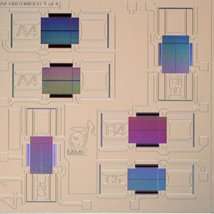Making beautiful music, on a microscopic scale

Strings a fraction of the thickness of a human hair, with microscopic weights to pluck them: researchers and students from the MESA+ Institute for Nanotechnology of the University of Twente, The Netherlands, have succeeded in constructing the first musical instrument with dimensions measured in mere micrometres - a 'micronium' - that produces audible tones. A composition specially written for the instrument was performed in Enschede on Sunday 26 September.
Earlier musical instruments with these minimal dimensions only produced tones that are inaudible to humans. But thanks to ingenious construction techniques, students from the University of Twente have succeeded in producing scales that are audible when amplified. To do so, they made use of the possibilities offered by micromechanics: the construction of moving structures with dimensions measured in micrometres (a micrometre is a thousandth of a millimetre). These miniscule devices can be built thanks to the ultra-clean conditions in a 'clean room', and the advanced etching techniques that are possible there. "You can see comparable technology used in the Wii games computer for detecting movement, or in sensors for airbags", says PhD student Johan Engelen, who devised and led the student project.
.jpg)
TUNING
The tiny musical instrument is made up of springs that are only a tenth of the thickness of a human hair, and vary in length from a half to a whole millimetre. A mass of a few dozen micrograms is hung from these springs.
The mass is set in motion by so-called 'comb drives': miniature combs that fit together precisely and shift in relation to each other, so 'plucking' the springs and creating sounds. The mass vibrates with a maximum deflection of just a few micrometres. This minimal movement can be accurately measured, and produces a tone. Each tone has its own mass spring system, and six tones fit on a microchip. By combining a number of chips, a wider range of tones can be achieved. "The tuning process turned out to be the greatest challenge", says Engelen. "We can learn a lot from this project for the construction of other moving structures. Above all, this is a great project for introducing students to micromechanics and clean room techniques."
.jpg)
CONCERT
The micronium played a leading role at the opening of a two-day scientific conference on micromechanics in the Atak music venue in Enschede on Monday 27 and Tuesday 28 September. A composition has been specially written for the instrument: 'Impromptu No. 1 for Micronium' by Arvid Jense, who is studying MediaMusic at the conservatorium in Enschede. The work was performed by an ensemble of conservatorium students, who were also playing conventional musical instruments. The performance took place on 26 September at Atak in Enschede, the Netherlands.
More information: A scientific paper - 'A musical instrument in MEMS' - has also been devoted to the instrument, and this will be presented to the conference by Johan Engelen.
Provided by University of Twente


















